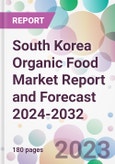Organic food in South Korea encompasses a range of products cultivated without the use of synthetic fertilisers, pesticides, or genetically modified organisms. These foods, often perceived as more nutritious and environmentally friendly, have seen a steady climb in their appeal among the Korean populace, primarily due to the overarching global trend leaning towards cleaner, sustainable eating.
At the crux of the South Korean organic food boom is the mounting consumer consciousness about the health benefits associated with organic consumption. With increasing research highlighting the adverse effects of chemically-treated food - from potential carcinogenicity to hormonal disruptions - there's a palpable shift towards organic products, perceived as safer and more nutritious.
Additionally, the blossoming fitness and wellness culture in South Korea has further amplified the South Korea organic food market demand. As health enthusiasts and fitness aficionados strive for holistic wellness, the emphasis on clean, chemical-free nutrition has grown, pushing organic foods from niche corners of supermarkets to mainstream aisles.
South Korea’s organic food market isn't just confined to fruits and vegetables. The organic wave has permeated other segments like dairy, meat, and packaged foods. Organic dairy products, such as milk and cheese, are gaining traction, with consumers increasingly associating organic with enhanced quality and taste. Similarly, the demand for organic meat, devoid of antibiotics and growth hormones, is surging, aligning with the trend of conscientious consumption.
Beyond individual health, environmental consciousness also plays a pivotal role in driving organic food market in South Korea. With escalating concerns about environmental degradation, the sustainable farming practices associated with organic cultivation - from soil conservation to reduced water pollution - resonate with the eco-conscious Korean consumers, further propelling South Korea organic food market expansion.
Nevertheless, the South Korean government, recognising the potential of the organic sector, has been proactive. Investments in organic farming research, subsidies to organic farmers, and initiatives to boost consumer awareness have been pivotal in fostering South Korea organic food market growth.
Market Segmentation
The market can be divided based on product type, process, and distribution channel.
Market Breakup by Product Type
- Fruits and Vegetables
- Meat, Fish, and Poultry
- Dairy Products
- Cereals and Grain
- Others
Market Breakup by Process
- Processed
- Unprocessed
Market Breakup by Distribution Channel
- Supermarkets and Hypermarkets
- Convenience Stores
- Speciality Stores
- Online Stores
- Others
Competitive Landscape
The report looks into the market shares, plant turnarounds, capacities, investments, and mergers and acquisitions, among other major developments, of the leading companies operating in the South Korea organic food market. Some of the major players explored in the report are as follows:- Pulmuone Corporate
- Maeil Co.Ltd
- HiPP GmbH & Co. Vertrieb KG
- The Chorocmaeul Co., Ltd.
- Others
Table of Contents
Companies Mentioned
- Pulmuone Corporate
- Maeil Co.Ltd
- HiPP GmbH & Co. Vertrieb KG
- The Chorocmaeul Co. Ltd.
Methodology

LOADING...








